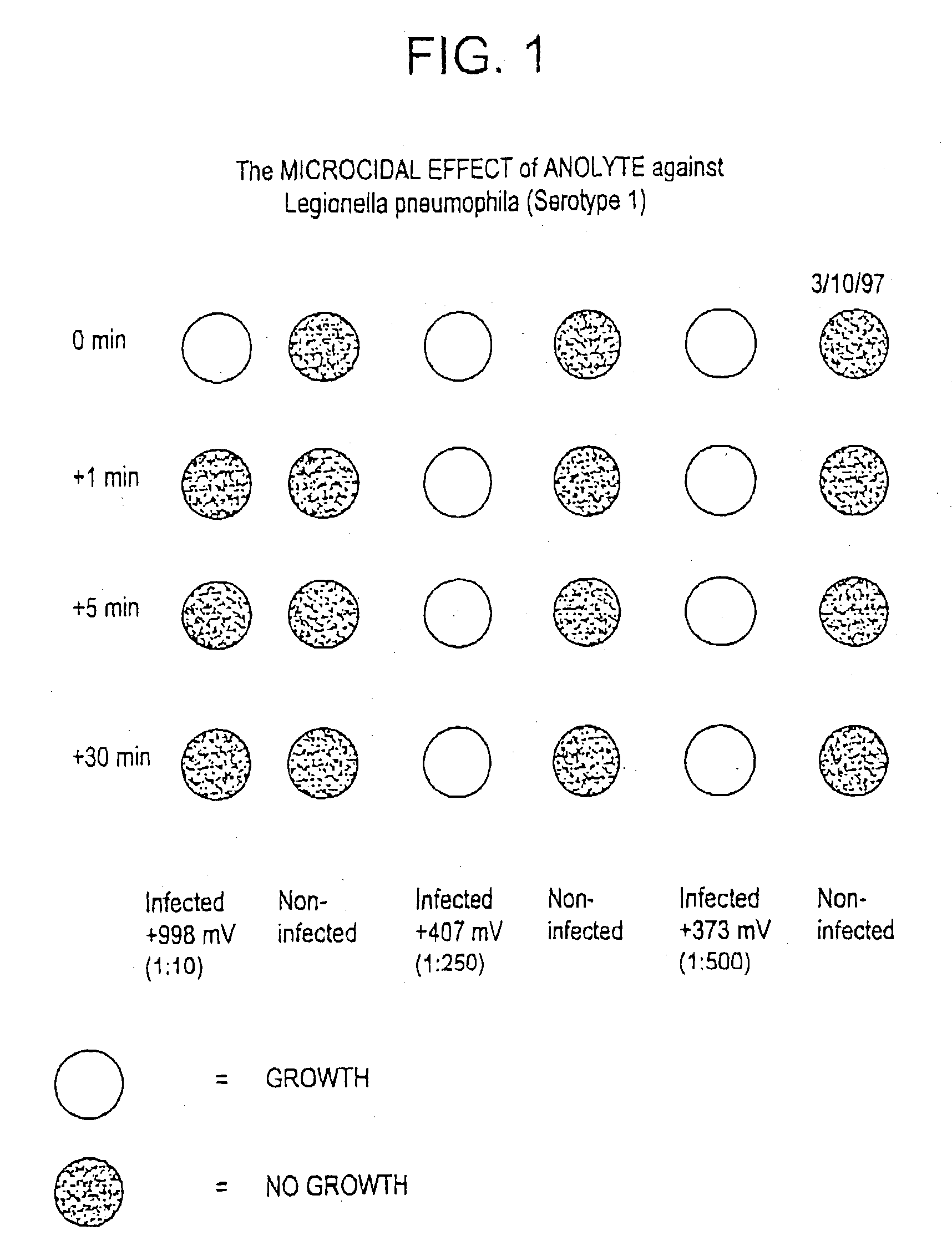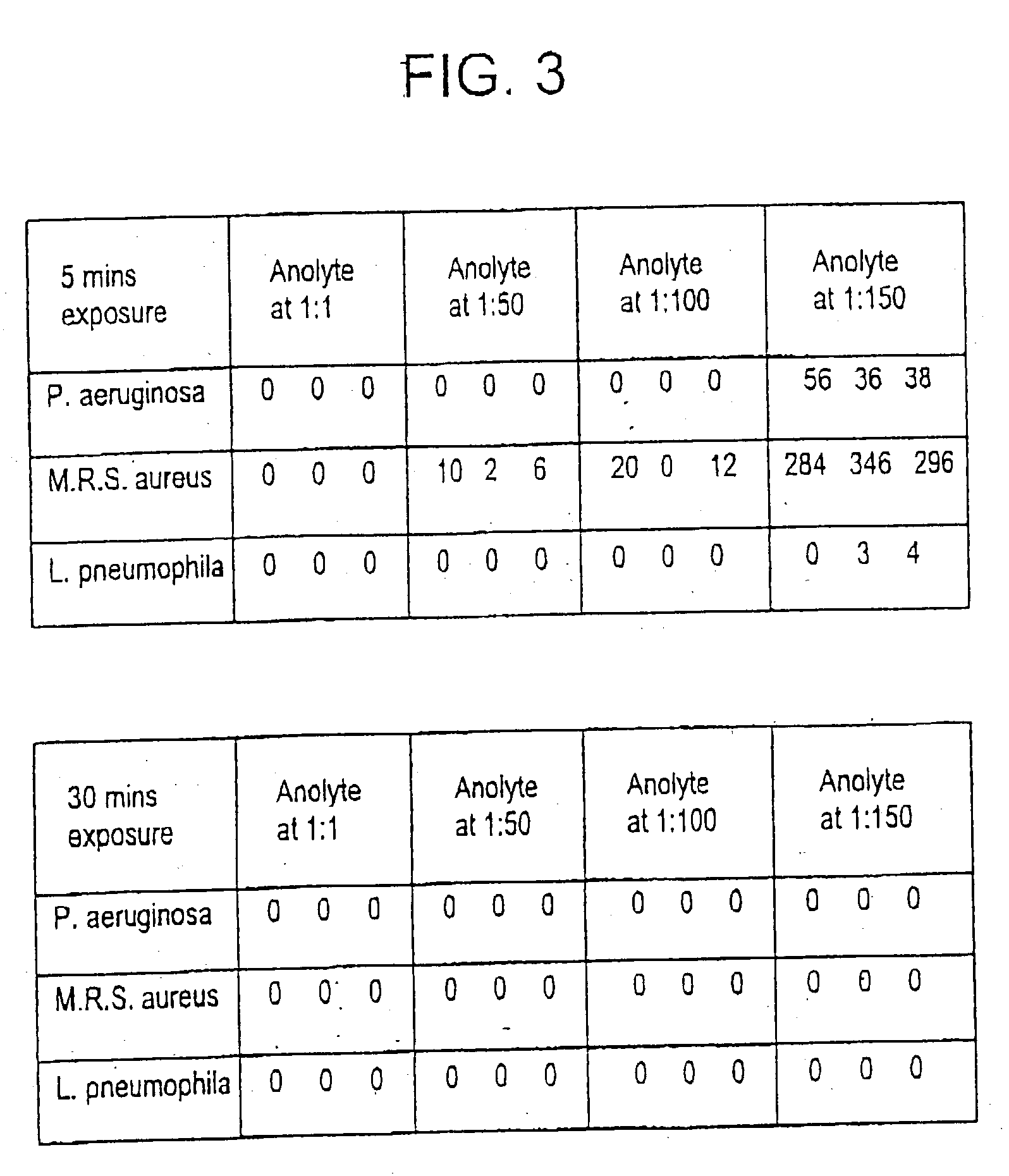Composition for the treatment of legionella pneumophila and a method for such treatment
a technology of legionella pneumophila and composition, which is applied in the direction of biocide, water treatment parameter control, specific water treatment objectives, etc., can solve the problems of no operating, maintenance, cleaning and decontamination procedures that are generally regarded as safe work practices
- Summary
- Abstract
- Description
- Claims
- Application Information
AI Technical Summary
Benefits of technology
Problems solved by technology
Method used
Image
Examples
example 1
[0015] Anolyte solution with varying characteristics was used as shown in the respective examples.
[0016] A series of trials have been conducted whereby various dilutions of aqueous anion-containing solutions have been seeded with Legionella pneumophila (Serotype 1) organisms and the microcidal effects of treatment with anolyte have been observed after incubation for a period of 4 days (96 hours) at a temperature of 37.degree. C.
[0017] The efficacy of the treatment with anolyte at the various dilutions and times of exposure was established by the presence or absence of Legionella cultures on the infected BCYE culture medium.
[0018] Three replicates of each of the dilutions and of the control groups were seeded with a pure culture of Legionella Pneumophila (Serotype 1), resulting in counts of above 7 million parts per millilitre (TNTC).
[0019] Samples were collected at pre-determined time intervals and transferred onto the growth medium before being incubated for 4 days (96 hours) at .+...
example 2
[0021] Further tests were then conducted to narrow down the ranges of efficacy using a reducing-oxidation potential (ORP) as the monitoring (measuring) and on a similar basis as set out in Example 1.
[0022] As is illustrated in the Table for Example 2, it is deduced that:
[0023] 1. A contact time of about 5 minutes at about 750 mV and a contact time of about 30 minutes at about +607 mV is completely microcidal against Legionella Pneumophila (Serotype 1); and
[0024] 2. The microcidal effect of anolyte is directly proportional to the ORP of the dilution.
example 3
[0025] P.aeruginosa and S.aureus (Methicillin resistant) strains were cultured overnight on blood agar plates. Both of these strains were obtained from clinical specimens obtained during routine laboratory investigations at the General Hospital in Johannesburg, South Africa. The L. pneumophila strain was cultured for 3 days on BCYE agar as it is a slow-growing organism. This isolate was obtained from the ATCC (American type culture collection) reference stock cultures, designated ATCC 33155.
[0026] These plate cultures were used for preparation of the liquid suspensions in Ringer's solution.
[0027] A suitable inoculum of each of the 3 test strains was removed from the agar plates with a nichrome loop and emulsified in 1 / 40 strength Ringer's buffer. These were then homogenised in a vortex mixer (the 1 / 40 Ringer's buffer is suitable for diluting the fastidious Legionella as well as the S.aureus and P.aeruginosa). Using a 0.5 McFarland's standard opacity tube, which is the equivalent to ...
PUM
| Property | Measurement | Unit |
|---|---|---|
| Electric potential / voltage | aaaaa | aaaaa |
| Area | aaaaa | aaaaa |
| Volume | aaaaa | aaaaa |
Abstract
Description
Claims
Application Information
 Login to View More
Login to View More - R&D
- Intellectual Property
- Life Sciences
- Materials
- Tech Scout
- Unparalleled Data Quality
- Higher Quality Content
- 60% Fewer Hallucinations
Browse by: Latest US Patents, China's latest patents, Technical Efficacy Thesaurus, Application Domain, Technology Topic, Popular Technical Reports.
© 2025 PatSnap. All rights reserved.Legal|Privacy policy|Modern Slavery Act Transparency Statement|Sitemap|About US| Contact US: help@patsnap.com



